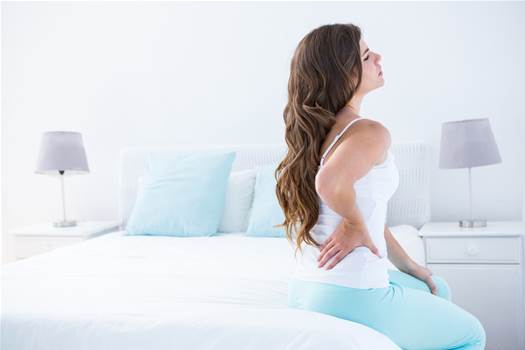


Adults are in pain. A 2015 study from the National Institutes of Health showed that 25 million U.S. adults cope with chronic pain every day. While everyone’s suffering is different—there are as many sources of pain as people—for many, how you sleep plays a crucial role.
Members of my own family are a part of this statistic: My grandma has purchased every pillow on the market to find one that supports her ever-aching neck, and my father relies on physical therapy exercises to keep his shoulder pain in check. I myself have tried purchasing a supportive mattress and pliable pillow, and I eat healthy and exercise regularly, but I still feel sore and stiff in the morning. According to the experts, it might be time to change my sleeping position.
Advice for side-sleepers
Most Americans sleep on their sides, according to the National Sleep Foundation. While many of them presumably do it without pain, this is not the best way to sleep. It can cause shoulder and hip pain, for one.
On top of that, several studies have shown that sleeping on your right side can aggravate heartburn. Scientists think that’s because lying in this position loosens your lower esophageal sphincter, the involuntary muscles that keep acid from rising up out of your stomach and into your throat. Sleeping on the left side, however, seems to keep the trap door between the throat and stomach shut, so leftie sleepers are less likely to feel the burn.
Shelby Harris, a sleep medicine expert and a professor at Albert Einstein College of Medicine, says that there’s no need to change your sleep position if it’s working for you. But if you’re waking up in pain, you can take steps to improve your situation.
She says side sleepers should buy pillows that are thick enough to support their heads, taking some of the pressure off their shoulders. If you experience acid reflux or heartburn, try to sleep on your left side. And, Harris says, tuck a pillow under your knees to better support your lower back.
101 on stomach sleeping
Side sleeping is hardly the worst of it. Though they’re rare, the seven percent of stomach sleepers are likely doing themselves a world of hurt. Because this position puts pressure on the entirety of their body, they’re at risk of numbness and tingling. If they turn their head to one side or another to breathe, that further increases the possibility of muscle and joint pain.
If you’re a stomach sleeper, Harris recommends using a flatter pillow to reduce strain on your neck. Other doctors suggest putting a pillow underneath your forehead to elevate your mouth and nose. This lets you sleep with your face straight down, eliminating that crick in the neck altogether.
Back sleeping is best
Only eight percent of people sleep on their backs. If you’re naturally one of them, count your lucky sheep. Back sleeping is the best option for pain management, as it allows your body to rest in a neutral position, which is great for reducing aches. It also cuts down on heartburn, as it keeps your head elevated above your chest.
For a back sleeper, Harris recommends resting your head on a pillow that’s thick—or thin—enough to keep your skull exactly level with your body. But, she warns, even with a perfect pillow, this position is not great for snorers. Back sleeping can cause sleep apnea or exacerbate existing cases of the disorder. So if you’re prone to this problem, or find yourself suddenly suffering from new symptoms while lying on your back, then this isn’t the pose for you.
Wikimedia Commons
Switch your sleep position
Even after taking this advice, side- and stomach-sleepers may still wake up sore. As a last resort, Harris says you can actually train yourself to sleep on your back.
When you’re ready for bed, put pillows on both sides of your body, and one under your knees. This should hold you in place and keep you from flipping to one side.
If that doesn’t cut it, Harris has an advanced method: Sew a tennis ball into the lining of your shirt on whatever side you need to avoid. When you flop onto your side or stomach, the discomfort will ensure you flip back over, even if you’re dead asleep.
The proposition of changing the way you sleep seems preposterous. After all, you’re asleep. How much can you really control? As an achy side-sleeper, I took the challenge myself, using a knee pillow and side pillows in an attempt to train myself to sleep on my back. I found it took longer to fall asleep, but that when I did, I stayed in place, and when I woke up later in the night, I found my eyes staring at the ceiling.
Back-sleeping significantly improved my neck and shoulder pain—but it was also nearly impossible to commit to. Sleeping on my back didn’t feel natural; I craved curling up in the fetal position. And that, Harris says, is where the rubber meets the repose.
“Although it is commonly recommended that sleeping on your back is the best position to sleep in, comfort is key,” she says. “If you’re in pain or uncomfortable from your sleep position, it can definitely impact your sleep quality.” In other words, if changing your sleep position makes you feel better, that’s great. But Harris stresses you still need to sleep soundly to stay healthy. “Sleep quality is extremely important in your overall health, memory, mood, and energy,” she says. When trying to sleep differently starts disrupting your circadian rhythms, then you know it’s not worth it.
Personally, I’m still trying to start my night sleeping on my back, but I don’t get upset if I wake to find I turned over in the night. My hope is that, along with other alterations to my nighttime habits, I’ll have more days when I wake up rested—and maybe even ready to jump out of bed.

EDITOR'S PICKS








